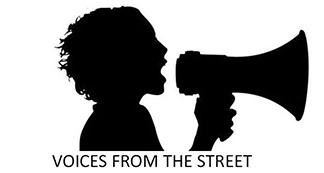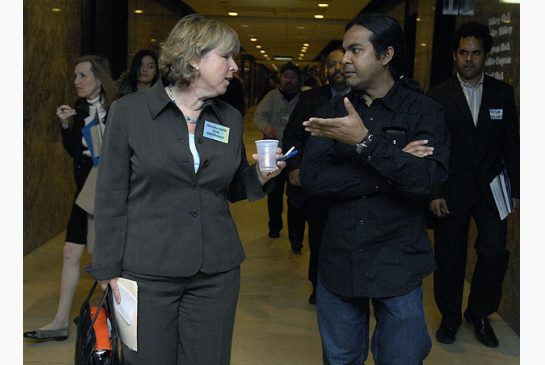Laurie Monsebraaten
April 15, 2008
Cabinet minister Deb Matthews talks with anti-poverty activist Dip Habib, of the East Scarborough Storefront, at a forum at Queen’s Park, April 14, 2008. (TONY BOCK / TORONTO STAR)
Ontario can’t say it will cut poverty by 25 per cent in five years until it has defined the problem, says the chair of a cabinet committee drafting the Liberals’ promised anti-poverty strategy.
“I’m happy to have an ambitious goal on a significant reduction in poverty,” Children and Youth Minister Deb Matthews told reporters after attending a forum of about 500 anti-poverty activists at Queen’s Park yesterday.
“But 25 per cent of what?” she asked. “How are we going to measure our progress? How are we going to measure poverty? This is one of our big challenges.”
The activists, part of a growing coalition with members as varied as the City of Toronto, teachers’ federations, Ryerson University, health-care and immigrant groups, want the
Liberals to follow countries such as the U.K. that have reduced poverty by almost 25 per cent in the past five years. They call themselves the 25-in-5 Network for Poverty Reduction.
Canada doesn’t have an official poverty line, Matthews said. However, the number most often cited is Statistics Canada’s low-income cut-off, which for a single person in Toronto in 2006 was $17,570 after taxes. For a family of four it was $33,221. (The before-tax amounts were $21,202 for a single person and $39,399 for a family of four.)
But income alone doesn’t tell the whole story, Matthews said.
For example, many children in low-income households struggle in school and never reach their potential, she said. “How do we get at measuring that kind of progress?” she asked. “It’s way more than just an income measure.”
Matthews said the government is considering several different indicators to measure the complexity of poverty and is looking at what other countries use.
She said she will be seeking public input when formal consultations on the plan begin later this spring.
“We were elected on a number of planks in our platform. One was not to raise taxes. And one was not to run a deficit. So we have to live within that reality,” Matthews told reporters. “But I’m very, very confident we’re going to be able to do a lot of very good things within that reality,” she said.
“I can assure you we are very, very serious about developing a comprehensive poverty reduction strategy,” Matthews said. “We can’t afford poverty. It’s in our economic best interests to really address poverty.”
The gathering, which included about 50 people living in poverty, urged Matthews and her government to make bold changes to improve the lives of some 1.3 million Ontarians living below Statistics Canada’s low-income cut-offs.
One of those was Michael Creek, a 50-year-old former Toronto business manager whose battle with cancer in 1993 left him unable to work. But it wasn’t the cancer or mental illness that broke his spirit, he told the forum. It was poverty.
Unable to afford TTC fare for anything but doctors’ appointments or shopping, Creek became increasingly lonely and isolated.
“The last time I went to a movie theatre was to see The Lion King,” he said. “This is how I started to disappear as a person.”
Matthews, who seemed moved by the stories of Meeks and others who spoke, said one of the government’s goals is to change the way it provides services and income support to ensure people are helped and not further marginalized.
“We need to turn government on its ear. We need to develop person-centred strategies … build on the strengths of people, not on their pathologies,” she said.
Although the group is excited by the Liberals’ commitment to tackling poverty with a comprehensive, long-term strategy by year’s end, members realize there is still an appetite in Ontario for tax cuts and less government.
“There are many who adhere to the view that if you’re poor it’s your own fault and, as a result, government has no business, no legitimate role to play ameliorating, reducing or eradicating poverty,” said Nick Saul of the Stop Community Food Centre. And there are many competing interests at the cabinet table, he told the group.
But the 25-in-5 network hopes the province will run with its demands to “poverty proof” the minimum wage; enhance social benefits for children and those unable to work; and beef up supports such as child care and affordable housing.
Credit: Toronto Star

